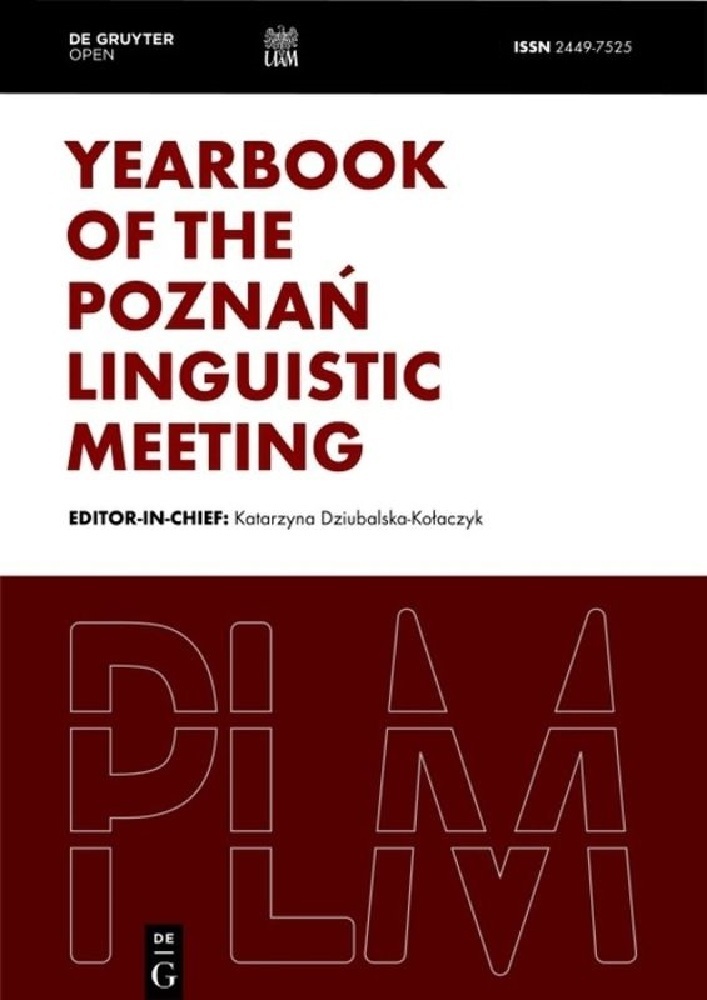Abstract
Cinque’s (1999) cartographic theory associates one meaning with one functional head. As such, if applied to sentence-final particles (SFPs), cartographic assumptions ought to group semantically similar SFPs onto the same functional head cross-linguistically (cf. Pan 2019; Sybesma & Li 2007). However, I show that aspectual and restrictive focus SFPs in Cantonese and Mandarin (Sinitic, Sino-Tibetan) seemingly contradict Cinque by occupying different structural positions despite their semantic closeness. To shed light on the problem, I adduce novel data from Guangzhou Cantonese and Singapore Cantonese, demonstrating that SFPs borrowed into these varieties are treated differently according to their structural height. Likewise citing scopal and other facts, I ultimately make a case for placing SFPs in multiple phases (Chomsky 2000 etc.), following Erlewine (2017) and Biberauer (2017), but contra Pan (2019), a.o. To accommodate Cinque (1999), I ultimately submit that different-phase SFPs constitute distinct lexical classes, which each cluster separately, but in the same semantically determined sequence compatible with cartographic assumptions.
References
Biberauer, T. & M. Sheehan. 2011. “Introduction: Particles through a modern syn-tactic lens.” The Linguistic Review, 28(4). 387-410.
Biberauer, T. 2017. “The Final-over-Final Condition and Particles.” In: Sheehan, Michelle et al. (eds.) The Final-Over-Final Condition: A Syntactic Universal, pp.76-187. MIT Press.
Bidese, E. et al. 2013. Bilingual competence, complementizer selection and mood in Cimbrian. In Abraham, W. & E. Leiss (eds.) Dialektologie in neuem Gewand. Zu Mikro-/Varietätenlinguistik, Sprachenvergleich und Universalgrammatik, 47–58. Hamburg: Buske.
Cardinaletti, A. 2011. German and Italian modal particles and clause structure. The Linguistic Review, 28(4). 493-511. Mouton de Gruyter.
Chan, T. T. 2020. The Cartography of Sentence-Final Particles in Yue Chinese – Evidence from Comparative Analysis and Language Contact. Master’s thesis, The Hong Kong University of Science and Technology.
Cheong, P. S. E. 2016. Sentence-final already and only in Singapore English. Hon-ours thesis, National University of Singapore.
Chomsky, N. 2000. Minimalist inquiries: The framework. In Martin, R. et al. (eds.) Step by step: Essays on minimalist syntax in honor of Howard Lasnik, 89-155. Cambridge, Massachusetts: MIT Press.
Cinque, G. 1999. Adverbs and Functional Heads: A Cross-linguistic Perspective. Oxford: Oxford University Press.
Erlewine, M. Y. 2010. Sentence-final only and the interpretation of focus in Manda-rin Chinese. In The Proceedings of the 22nd North American Conference of Chi-nese Linguistics (NACCL 22) and the 18th Annual Meeting of the International Association of Chinese Linguistics (IACL 18), 18– 35.
Erlewine, M. Y. 2017. Low sentence-final particles in Mandarin Chinese and the Final-over-Final Constraint. Journal of East Asian Linguistics, 26. 37-75.
Fung, R. S. 2000. Final particles in Standard Cantonese: Semantic extension and pragmatic inference. Doctoral dissertation, Ohio State University.
Gast, V. & J. van der Auwera. 2012. What is 'contact-induced grammaticalization?' Evidence from Mayan and Mixe-Zoquean languages. In Wiemer, B. et al. (eds.) Grammatical Replication and Borrowability in Language Contact, 381-426. De Gruyter Mouton.
Jackendoff, R. 1972. Semantic interpretation in generative grammar. Cambridge: MIT.
Kayne, R. .1994. The antisymmetry of syntax. Cambridge: MIT.
Kwok, H. 1984. Sentence Particles in Cantonese. University of Hong Kong.
Lai, Y. Y. 2014. Temporal modification in Cantonese: The semantic study of the sentence-final particle lei4 in simplex and bi-clausal sentences. Doctoral disserta-tion, City University of Hong Kong.
Law, A. 2002. Cantonese sentence-final particles and the CP domain. UCL Working Papers in Linguistics, 14. 375-98.
Lee, H. T. & C. Yiu. 1998. Final ‘de’ and ‘ge3’: A nominalization analysis for cleft sentences in Mandarin and Cantonese. Paper presented at the LSHK Annual Research Forum, The Hong Kong Polytechnic University.
Leimgruber, J. R. E. 2013. Singapore English: Structure, Variation, and Usage. Cambridge University Press.
Li, B. 2006. Chinese final particles and the syntax of the periphery. PhD dissertation, Universiteit Leiden.
Li, I. C. 1999. Utterance-Final Particles in Taiwanese: A Discourse-pragmatic Anal-ysis. Taipei: The Crane.
Matthews, S. & V. Yip. 2011. Cantonese: A Comprehensive Grammar. Routledge.
Pan, V. J. 2019. Architecture of the Periphery in Chinese: Cartography and Minimal-ism. London and New York: Routledge.
Pan, V. J. 2019b. Derivation of the Apparent Narrow Scope of Sentence-Final Parti-cles in Chinese: A Reply to Erlewine (2017). Studies in Chinese Linguistics, 39(2). 99-126.
Paul, W. 2014. Why particles are not particular: Sentence-final particles in Chinese as heads of a split CP. Studia Linguistica, 68(1). 77-115.
Radford, A. 2006. Minimalist Syntax Revisited. Retrieved on 21-10-2019 from URL: http://www.public.asu.edu/~gelderen/Radford2009.pdf.
Rizzi, L. 1997. The fine structure of the left periphery. In Haegeman, L. (ed.) Ele-ments of Grammar, 281-337. Dordrecht: Kluwer.
Rooth, M. 1985. Association with focus. Doctoral dissertation, University of Massa-chusetts, Amherst.
Sybesma, R. & Li, B. 2007. The dissection and structural mapping of Cantonese sentence final particles. Lingua, 117. 1739-89.
Tang, S. 1998. Parametrization of Features in Syntax. Doctoral dissertation, Univer-sity of California, Irvine.
Tang, S. 2015. Yueyu yufa jiangyi (Lectures on Cantonese Grammar). Hong Kong: The Commercial Press.
Wong, J. O. 2014. The culture of Singapore English. Cambridge University Press.
Yiu, C. Y. 2001. Cantonese final particles ‘‘lei’’, ‘‘zyu’’ and ‘‘laa’’: an aspectual study. M.Phil. thesis, The Hong Kong University of Science and Technology.
Åfarli, T.A. 2015. “A syntactic model for the analysis of language mixing phenome-na: American Norwegian and beyond”. In Page, B. R. & M. T. Putnam (eds.), Moribund Germanic heritage languages in North America, pp. 12–33. Leiden: Brill.
License
All papers published by the Yearbook of the Poznań Linguistic Meeting are published in an Open Access model using the CC-BY-NC-ND 4.0 Creative Commons licence.

